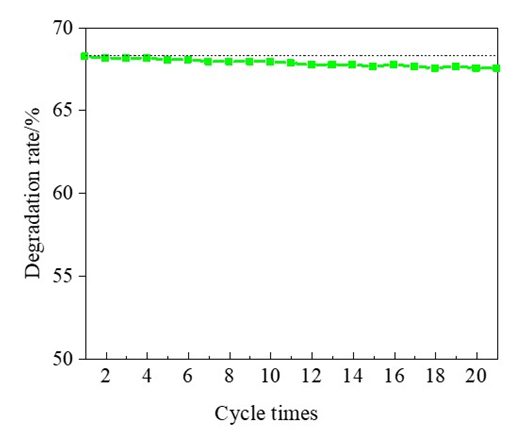摘要/Abstract

为了提高TiO2在可见光下的光催化活性, 采用聚合物前驱体法制备了B,N共掺杂的SnO2/TiO2(B,N-SnO2/TiO2)粉体型光催化剂. 进一步为了提高光催化剂的实用性, 通过浸渍-裂解法制备了氧化铝纤维毡负载的B,N-SnO2/TiO2光催化剂. 利用X射线衍射仪、场发射扫描电子显微镜、场发射透射电子显微镜、X射线光电子能谱、比表面积分析仪、紫外-可见分光光度计等对其进行了表征. 以氧氟沙星水溶液为模拟污染物, 考察了B,N-SnO2/TiO2粉体型光催化剂和负载型光催化剂的可见光催化活性及稳定性. 结果表明, 该粉体型光催化剂在可见光下光照15 min, 对氧氟沙星的降解率可达98.3%. 负载型光催化剂也表现出了良好的光催化性能及可重复性和稳定性, 在21次重复使用后光催化性能几乎不发生变化.
关键词: 二氧化钛, 二氧化锡, 氧氟沙星, 负载, 可见光催化降解
In order to improve the photocatalytic activity of TiO2 under visible light, B,N-codoped SnO2/TiO2 (B,N-SnO2/TiO2) powder photocatalysts were prepared by polymer precursor method, and to further improve the practicability of B,N-SnO2/TiO2 photocatalyst, alumina fabrics immobilized B,N-SnO2/TiO2 catalyst was prepared by precursor impregnation and pyrolysis method. The typical experimental procedure for synthesis of B,N-SnO2/TiO2 powder photocatalysts is as follows: First, tetrapropylorthotitanate (TNPT) was mixed with PEG-600 and Sn(OPr)4 under magnetic stirring and refluxed for 2 h. Then boric acid was added. Acetamide and acetylacetone were added to the system after boric acid was dissolved completely. Finally, a mixture of deionized water and n-propanol were added dropwise. The whole solution were reflux for 1 h and then the B,N-SnO2/TiO2 precursor was obtained by rotary evaporation method. The precursor was placed in a quartz tube furnace and calcined at a heating rate of 3 ℃/min to 450 ℃ for 30 min to obtain B,N-SnO2/TiO2 powder type photocatalyst. Supported photocatalysts was prepared as follows: The precursor solution of B,N-SnO2/TiO2 was diluted with n-propanol and heated at 100 ℃ for 1 h. The alumina fabrics was immersed in the loaded solution and heated at 100 ℃ for 1 h. Then the precursor immersed fabrics was dried by rotary evaporation method. Supported photocatalysts were obtained by calcining the dried fabrics at 450 ℃ for 30 min in air atmosphere. The catalysts were characterized by X-ray diffraction (XRD), scanning electron microscope (SEM), high-resolution transmission electron microscope (HRTEM), X-ray photoelectron spectroscopy (XPS) and UV-Vis diffuse reflectance spectra (UV-DRS). B,N-SnO2/TiO2 powder photocatalysts were predominantly homogeneous anatase phase. The introduction of boron inhibited the growth of anatase phase crystal, and the grain size was 15 nm, showing a stacking structure. The results of HRTEM and energy dispersive spectrometer (EDS) showed that SnO2 and TiO2 constructed heterostructure, and the doped elements existed and distributed evenly. Boron and nitrogen co-doping and heterojunction structure effectively improved the separation ability of photogenerated carriers. The photocatalytic activities of B,N-SnO2/TiO2 powder photocatalysts were investigated using ofloxacin solution as simulated pollutant. The results indicated that the degradation ratio of ofloxacin reached 98.3% in 15 min under visible light. The B,N-SnO2/TiO2-loaded Al2O3 fabrics also showed excellent photocatalytic performance, with a thickness of about 100 nm powder photocatalysts on the surface of Al2O3 fabrics, and the heterostructure still existed. The results showed that the degradation rate of ofloxacin was 68.7% under visible light irradiation for 120 min, and the photocatalytic performance was almost unchanged after repeated use for 21 times.
Key words: TiO2, SnO2, ofloxacin, loaded, visible light catalytic degradation
PDF全文下载地址:
点我下载PDF
